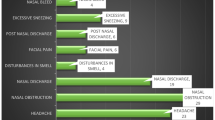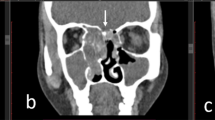Abstract
Objective
Fungal rhinosinusitis occurs in different forms depending on race and region. While allergic fungal rhinosinusitis is common in Caucasians, fungal ball (FB) is more common in Asians. However, most cases are reported as unilateral, and clinical data on bilateral FB (BFB) are rare. Therefore, the purpose of this study was to analyze and to compare the clinical characteristics of BFB and unilateral FB (UFB) in Koreans.
Methods
We retrospectively analyzed medical records and computed tomography (CT) images of 434 patients diagnosed with FB. The patients were divided into two groups: BFB and UFB. Demographic data, multiple allergen simultaneous test including total or specific immunoglobulin E (IgE) levels, symptoms, CT findings, treatment, and outcomes were analyzed.
Results
Among the patients, 26 had BFB and 408 had UFB. Hypertension was noted in 61.5% of the BFB and 39% of the UBF individuals (p = 0.023). While total IgE levels were similar between the two groups, Dermatophagoides pteronyssinus (p = 0.004), Cladosporium (p = 0.017), and Aspergillus-specific IgE positivity (p = 0.025) were significantly higher in the BFB than in the UFB group. Not only symptoms such as postnasal drip (p = 0.013), mucopurulent rhinorrhea (p = 0.009), and foul odor (p = 0.037), but also sphenoid sinus involvement on CT images were more common in the BFB than in the UFB group (p = 0.011).
Conclusion
Patients with BFB in Korea showed more common hypertension and symptoms of foul odor, mucopurulent rhinorrhea, and postnasal drip with allergy positivity compared to those with UFB. Therefore, understanding clinical characteristics of BFB will allow clinicians to approach BFB more appropriately.
Similar content being viewed by others
References
Chakrabarti A, Kaur H (2016) AllergicAspergillus rhinosinusitis. J Fungi (Basel) 2(4)
Grosjean P, Weber R (2007) Fungus balls of the paranasal sinuses: a review. Eur Arch Otorhinolaryngol 264(5):461–470
Chakrabarti A, Denning DW, Ferguson BJ, Ponikau J, Buzina W, Kita H, Marple B, Panda N, Vlaminck S, Kauffmann-Lacroix C, Das A, Singh P, Taj-Aldeen SJ, Kantarcioglu AS, Handa KK, Gupta A, Thungabathra M, Shivaprakash MR, Bal A, Fothergill A, Radotra BD (2009) Fungal rhinosinusitis: a categorization and definitional schema addressing current controversies. Laryngoscope 119(9):1809–1818
Bent JP 3rd, Kuhn FA (1994) Diagnosis of allergic fungal sinusitis. Otolaryngol Head Neck Surg 111(5):580–588
Mensi M, Salgarello S, Pinsi G, Piccioni M (2004) Mycetoma of the maxillary sinus: endodontic and microbiological correlations. Oral Surg Oral Med Oral Pathol Oral Radiol Endod 98(1):119–123
Robey AB, O'Brien EK, Richardson BE, Baker JJ, Poage DP, Leopold DA (2009) The changing face of paranasal sinus fungus balls. Ann Otol Rhinol Laryngol 118(7):500–505
Yoon YH, Xu J, Park SK, Heo JH, Kim YM, Rha KS (2017) A retrospective analysis of 538 sinonasal fungus ball cases treated at a single tertiary medical center in Korea (1996–2015). Int Forum Allergy Rhinol 7(11):1070–1075
Torres C, Ro JY, El-Naggar AK, Sim SJ, Weber RS, Agalya AG (1996) Allergic fungal sinusitis: a clinicopathologic study of 16 cases. Hum Pathol 27(8):793–799
Lee DH, Joo YE, Lim SC (2013) Fungus balls of the bilateral paranasal sinuses. Indian J Otolaryngol Head Neck Surg 65(Suppl 2):320–323
Panda NK, Sharma SC, Chakrabarti A, Mann SB (1998) Paranasal sinus mycoses in north India. Mycoses 41(7–8):281–286
Rupa V, Jacob M, Mathews MS, Job A, Kurien M, Chandi SM (2002) Clinicopathological and mycological spectrum of allergic fungal sinusitis in South India. Mycoses 45(9–10):364–367
Michael RC, Michael JS, Ashbee RH, Mathews MS (2008) Mycological profile of fungal sinusitis: an audit of specimens over a 7-year period in a tertiary care hospital in Tamil Nadu. Indian J Pathol Microbiol 51(4):493–496
Klossek JM, Serrano E, Peloquin L, Percodani J, Fontanel JP, Pessey JJ (1997) Functional endoscopic sinus surgery and 109 mycetomas of paranasal sinuses. Laryngoscope 107(1):112–117
Dufour X, Kauffmann-Lacroix C, Ferrie JC, Goujon JM, Rodier MH, Klossek JM (2006) Paranasal sinus fungus ball: epidemiology, clinical features and diagnosis. A retrospective analysis of 173 cases from a single medical center in France, 1989–2002. Med Mycol 44(1):61–67
Pagella F, Matti E, De Bernardi F, Semino L, Cavanna C, Marone P, Farina C, Castelnuovo P (2007) Paranasal sinus fungus ball: diagnosis and management. Mycoses 50(6):451–456
Hsiao CH, Li SY, Wang JL, Liu CM (2005) Clinicopathologic and immunohistochemical characteristics of fungal sinusitis. J Formos Med Assoc 104(8):549–556
Lee BJ, Kim H, Kim JH, Kim YJ (1998) Fungal sinusitis: clinical features and treatment outcomes with emphasis on endoscopic sinus surgery. Korean J Otorhinolaryngol-Head Neck Surg 41(3):318–322
Kim JS, So SS, Kwon SH (2017) The increasing incidence of paranasal sinus fungus ball: a retrospective cohort study in two hundred forty-five patients for fifteen years. Clin Otolaryngol 42(1):175–179
Lee JS, Shin SY, Lee KH, Kim SW, Cho JS (2013) Change of prevalence and clinical aspects of fungal ball according to temporal difference. Eur Arch Otorhinolaryngol 270(5):1673–1677
Ferreiro JA, Carlson BA, Cody DT 3rd (1997) Paranasal sinus fungus balls. Head Neck 19(6):481–486
Nicolai P, Lombardi D, Tomenzoli D, Villaret AB, Piccioni M, Mensi M, Maroldi R (2009) Fungus ball of the paranasal sinuses: experience in 160 patients treated with endoscopic surgery. Laryngoscope 119(11):2275–2279
Lai JC, Lee HS, Chen MK, Tsai YL (2011) Patient satisfaction and treatment outcome of fungus ball rhinosinusitis treated by functional endoscopic sinus surgery. Eur Arch Otorhinolaryngol 268(2):227–230
Hong SC, Yoo YS, Kim ES, Kim SC, Park SH, Kim JK, Kang SH (1999) Development of KVSS Test (Korean Version of Sniffin' Sticks Test). Korean J Otorhinolaryngol-Head Neck Surg 42(7):855–860
Rim JH, Park BG, Kim JH, Kim HS (2016) Comparison and clinical utility evaluation of four multiple allergen simultaneous tests including two newly introduced fully automated analyzers. Pract Lab Med 4:50–61
Callejas CA, Douglas RG (2013) Fungal rhinosinusitis: what every allergist should know. Clin Exp Allergy 43(8):835–849
Ferguson BJ (2000) Fungus balls of the paranasal sinuses. Otolaryngol Clin N Am 33(2):389–398
Nomura K, Asaka D, Nakayama T, Okushi T, Matsuwaki Y, Yoshimura T, Yoshikawa M, Otori N, Kobayashi T, Moriyama H (2013) Sinus fungus ball in the Japanese population: clinical and imaging characteristics of 104 cases. Int J Otolaryngol 2013:731640
Kim SW, Park YJ, Kim SW, Kang MG, Joo YH, Cho JH (2005) A Clinical analysis of fungal sinusitis. Korean J Otorhinolaryngol-Head Neck Surg 48(3):332–337
Collins M, Nair S, Smith W, Kette F, Gillis D, Wormald PJ (2004) Role of local immunoglobulin E production in the pathophysiology of noninvasive fungal sinusitis. Laryngoscope 114(7):1242–1246
Tsai TL, Lan MY, Ho CY (2012) There is no structural relationship between nasal septal deviation, concha bullosa, and paranasal sinus fungus balls. Sci World J 2012:181246
Acknowledgements
None.
Funding
None.
Author information
Authors and Affiliations
Contributions
SHA: study concept and design, drafting of manuscript, manuscript revision. EJL: interpretation of data, revision of manuscript, MPH and GCS: collecting data, KSK: study concept and design, revision of manuscript, interpretation of data, approval of final version of manuscript to be published.
Corresponding author
Ethics declarations
Conflict of interest
All authors declared no conflicts of interest.
Informed consent and ethics committee review approval
This study was reviewed and approved by the Institutional Review Board (IRB). The study was also conducted in accordance with the ethical standards of the institutional and/or national research committee, 1964 Helsinki Declaration and subsequent amendments, or similar ethical standards.
Additional information
Publisher's Note
Springer Nature remains neutral with regard to jurisdictional claims in published maps and institutional affiliations.
Rights and permissions
About this article
Cite this article
Ahn, S.H., Lee, E.J., Hong, M.P. et al. Comparison of the clinical characteristics of bilateral and unilateral fungal balls in Korea. Eur Arch Otorhinolaryngol 276, 1975–1980 (2019). https://doi.org/10.1007/s00405-019-05408-6
Received:
Accepted:
Published:
Issue Date:
DOI: https://doi.org/10.1007/s00405-019-05408-6




